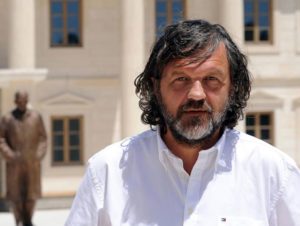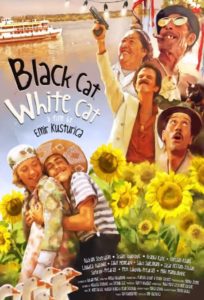
Deutsch | Romanes | Rumänisch
The series “Romani Voices” is giving people of the Roma community the opportunity to publish their opinions. The following text was written by Laura Moldovan. It is not a film review. It does not question the ability of Kusturica as a director. This text describes the perception of Laura Moldovan. It is her analysis of the “gypsies” that Kusturica shows in his films and an analysis of what these constructed “gypsies” and their caricatured world do with the perceptions of those who see these award-winning and highly acclaimed films.
The text is divided into 4 parts: an intro and 3 individual texts for different movies.
Part 1 Intro: Emir Kusturica and his “Gypsies”
You are here: Part 2: Opinion on “Time of the Gypsies” (1989)
Part 3: Opinion on “Black cat, white cat”
Part 4: Opinion on “Blue Gipsy – All the invisible children”
Part 2: Opinion on “Time of the Gypsies” (1989)
by Laura Moldovan
For generations now Roma activists and Roma who are politically active, have stated that the time has come for us take back our rights and stand up against injustice. For someone who has not seen Emir Kusturica’s piece “Time of the Gypsies”, the title might just as well address this emancipation of the Roma. Until one has to admit as a viewer, that “Time of the Gypsies” should rather have been called “Time of the anti-gypsies”.
About “Time of the Gypsies” Emir Kusturica said in 1989:
“Why the gypsies? The only reason is that I was shocked that you could sell children.”
Although human trafficking is a socio-political issue that affects not only Roma, but also many other groups of people worldwide, Kusturica diminishes the Roma in his film to this subject matter.
Kusturica decides after his research to represent the Roma in the film as the mafia. At the same time, he is selling this decision as an open-mined choice that enables him to depicture and to become acquired with a different, a foreign culture for the first time:

“Time of the Gypsies was my first step out of my garden – towards a different culture than my own. I started to learn how to look at another society “,
he explains in an interview with the French magazine “Le Monde” January 23, 1993.
Kusturica conceals the fact that Roma have been actively involved in shaping the Balkan culture for centuries. According to him this minority in Europe is foreign and exotic.
Following the release of the film “Guardian Angel” (1987) by Goran Paskaljevic, Kusturica came across a newspaper article about a case of child trafficking, in witch rumors circulated that the perpetrators were members of the ethnic group of the Roma. As part of his research Kusturica spoke with the authors of the article, journalists and spent a lot of time in a Roma community in Macedonia.
Since the Roma in his work are always referred to as “gypsies” it is probably a sign that Kusturica has only poorly researched the history of our people.
From the beginning, he is focusing exclusively on the representation of negative aspects of our life reality and always ready to embellish and inflate it.
Magical, mafia, godless and homeless


At times, the movie “Time of the Gypsies” even looks like a remake of the Godfather I & II. Kusturica has obviously got some ideas off Francis Ford Coppola.
Apart from the external similarity of the protagonists Perhan and Michael Corleone, as well as Ahmed and Vito Corleone, it also covers the same subjects as Coppola’s Mafia epos: The question of the successor of the godfather and of course the rise and fall of a family, a mafia clan.


For “Time of the Gypsies” Kusturica apparently also got inspired by the film “Amarcord” by Federico Fellini. Themes such as weddings and banquets in nature, a crazy storyteller at the beginning of the film, the accordion and even a scene with turkey-hypnosis are reminiscent of Fellini’s circus world.

The film is based on an extremely racist world view represented through various motives: The original title of the film (“Dom za vešanje”) in English basically means “The house to hang “. A scene in the movie is particularly fitting for the title, symbolizing that Roma have no real homes, no homeland and place in the world. This scene also stands for the steady “survival of the Roma”, who are still there even if others blow up or destroy their homes. For sales and marketing purposes the film title was changed abroad to “Time of the Gypsies”.
Weddings are a recurring theme in all of Kusturica’s films, including this one. Already the opening scene of the film shows a Romni in a wedding dress insulting her completely drunk husband and accusing him of having destroyed her life. This scene is repeated at the end in a different constellation.
Kusturica implies that Roma are miserable and bad husbands and not only destroy their own lives, but also the lives of their wives.
The main reason behind the behavior of all acting characters is being explained at the beginning of the film (see YouTube clip) by an obviously insane protagonist. He complains that he has been deprived of his freedom, had his wings and soul. Again, this imposes restlessness and homelessness on the Roma. My interpretation is that Kusturica wants to imply that the Roma do not want to integrate themselves but rather stubbornly insist on their alleged freedom in order to maintain their “own way of life”, even if this is disturbing to other people and causes them discomfort.

Another theme that shapes the film is religion combined with mysticism and magic. Also at the beginning of the film a legend about God and the Roma is introduced to the story. The legend tells how God came down to earth and left again because he could not stand the Roma. Thus, the Roma would ultimately be responsible for their unfortunate life situation, since they have even chased away the Lord himself. This legend does not exist within the Roma community, it is Kusturica’s invention. His psychological motivation behind it is questionable. Maybe he, like many directors, suffers from a God complex? Maybe he wanted to add even more magic and mystique to the film in order to reinforce the stereotypes?

Kusturica himself stated in an interview with the French journal L’Express (1989) that magic belongs to the life of the Roma. Therefore, he had given the character Perhan telekinetic abilities and equipped his grandmother with healing powers in the movie. The motif of the deterred God and the wedding, also returns at the end and creates a frame around the whole action: In the last scene of the film, a Roma prays to a fallen crucifix, which he picks up from the ground and hangs back on the wall. But when he tries to negotiate with God, the cross falls to the ground again.
Time of the geese

Kusturica explained in an interview his reference to geese in his films. He had heard a legend that highly fascinated him, according to which geese would have brought the “Gypsies” from India to Europe two thousand years ago. In gratitude, the Roma cut off the geese’s wings. The symbolism of the truncated wings appears again and again in Kusturica’s work and represents the loss of freedom. In fact, Roma left the Indian subcontinent about a thousand years ago – most likely without the help of geese.
For Kusturica, legends sound better than reality. Through them he can live out his racist ways of thinking and artistically strengthen Antigypsyism in our society.
If we want to believe Kusturica’s films, the Roma are destroying their lives single-handedly. They are not Europeans, but ever foreign people who must be endured by the native Europeans. After his box office hit “Time of the Gypsies” Kusturica brought his movie as a punk opera on the stages of Paris in 2007, musically accompanied by his band, the “No Smoking Orchestra”.
The gypsies of Emir Kusturica lost their feathers a long time ago. Whether Emir Kusturica should lose his pen also, is an open question.
Further artikels releated to Emir Kusturica:
Part 1 Intro: Emir Kusturica and his “Gypsies”
You are here: Part 2: Opinion on “Time of the Gypsies” (1989)
Part 3: Opinion on “Black cat, white cat”
Part 4: Opinion on “Blue Gipsy – All the invisible children”



